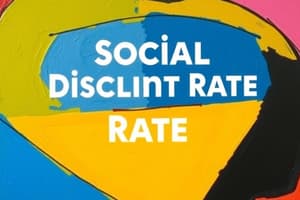Podcast
Questions and Answers
What is the Social Discount Rate (SDR) proposed by Stern?
What is the Social Discount Rate (SDR) proposed by Stern?
- 4.5%
- 10%
- 2.5%
- 1.4% (correct)
Which perspective did Nordhaus take regarding the SDR?
Which perspective did Nordhaus take regarding the SDR?
- Positive (correct)
- Speculative
- Prescriptive
- Normative
What is the main implication of Stern's SDR on climate change actions?
What is the main implication of Stern's SDR on climate change actions?
- It supports minimal action.
- It advocates for strong and immediate action. (correct)
- It promotes delaying action until future benefits are clearer.
- It favors long-term investments only.
How much would one have to sacrifice today for a benefit of 1000 CHF in 100 years according to Stern’s SDR?
How much would one have to sacrifice today for a benefit of 1000 CHF in 100 years according to Stern’s SDR?
What does Nordhaus suggest about immediate action on climate change?
What does Nordhaus suggest about immediate action on climate change?
What was a significant outcome of the debate over SDR among experts?
What was a significant outcome of the debate over SDR among experts?
What can explain the larger disagreement among policymakers compared to academics regarding the SDR?
What can explain the larger disagreement among policymakers compared to academics regarding the SDR?
What does Nordhaus's SDR imply for today's sacrifice for a future benefit of 1000 CHF?
What does Nordhaus's SDR imply for today's sacrifice for a future benefit of 1000 CHF?
What does the Social Time Preference (STP) approach focus on?
What does the Social Time Preference (STP) approach focus on?
Which of the following accurately describes the numeraire used in the Social Time Preference approach?
Which of the following accurately describes the numeraire used in the Social Time Preference approach?
What does the production-side approach measure?
What does the production-side approach measure?
When do the consumption-side and production-side approaches coincide?
When do the consumption-side and production-side approaches coincide?
What is the focus of the Social Discount Rate (SDR) in relation to societal preferences?
What is the focus of the Social Discount Rate (SDR) in relation to societal preferences?
What does the Simple Ramsey Rule express regarding the Social Discount Rate (SDR)?
What does the Simple Ramsey Rule express regarding the Social Discount Rate (SDR)?
Which of the following represents a challenge in determining the SDR according to the content?
Which of the following represents a challenge in determining the SDR according to the content?
What ethical consideration related to the calibration of δ is mentioned?
What ethical consideration related to the calibration of δ is mentioned?
What is indicated about societal weights on future utilities in the discussion of δ?
What is indicated about societal weights on future utilities in the discussion of δ?
In the equation for SDR, which variable represents the per capita growth rate?
In the equation for SDR, which variable represents the per capita growth rate?
The pure time discount factor δ is associated with which of the following concepts?
The pure time discount factor δ is associated with which of the following concepts?
What does η represent in the context of the SDR?
What does η represent in the context of the SDR?
Which of the following statements accurately reflects the debate surrounding δ?
Which of the following statements accurately reflects the debate surrounding δ?
What is the assumed form of the utility function when η is not equal to 1?
What is the assumed form of the utility function when η is not equal to 1?
Which assumption is made about the period-consumption growth rate in the social welfare calibration?
Which assumption is made about the period-consumption growth rate in the social welfare calibration?
What does the variable δ represent in the context of social welfare specification?
What does the variable δ represent in the context of social welfare specification?
How is the current social value of the project denoted in the social welfare calibration?
How is the current social value of the project denoted in the social welfare calibration?
What is the elasticity parameter η in the context of the isoelastic utility function?
What is the elasticity parameter η in the context of the isoelastic utility function?
When η equals 1, what form does the utility function take?
When η equals 1, what form does the utility function take?
Which aspect does the social welfare function account for over time?
Which aspect does the social welfare function account for over time?
What is the primary consideration of intergenerational fairness in the social welfare context?
What is the primary consideration of intergenerational fairness in the social welfare context?
What is the primary purpose of the Social Discount Rate (SDR)?
What is the primary purpose of the Social Discount Rate (SDR)?
How does the present value relate to the Social Discount Rate (SDR)?
How does the present value relate to the Social Discount Rate (SDR)?
In the context of project assessment, what does the term 'present values' refer to?
In the context of project assessment, what does the term 'present values' refer to?
Why is intergenerational fairness an important consideration in discounting?
Why is intergenerational fairness an important consideration in discounting?
What outcome might result from improperly applying the Social Discount Rate?
What outcome might result from improperly applying the Social Discount Rate?
Which aspect of project analysis is MOST affected by changes in the Social Discount Rate?
Which aspect of project analysis is MOST affected by changes in the Social Discount Rate?
What is a potential risk of having a high Social Discount Rate?
What is a potential risk of having a high Social Discount Rate?
How might an inappropriate discount rate influence decision-making in project funding?
How might an inappropriate discount rate influence decision-making in project funding?
What is Nordhaus' perspective on the urgency of action against climate change?
What is Nordhaus' perspective on the urgency of action against climate change?
According to Stern's rate, what is the sacrifice required today for a benefit of 1000 CHF in 100 years?
According to Stern's rate, what is the sacrifice required today for a benefit of 1000 CHF in 100 years?
What do some argue should be included in the derivation of the Social Discount Rate?
What do some argue should be included in the derivation of the Social Discount Rate?
What is a key point of disagreement regarding the Social Discount Rate (SDR)?
What is a key point of disagreement regarding the Social Discount Rate (SDR)?
What are market price approaches in the context of SDR?
What are market price approaches in the context of SDR?
What kind of extensions are suggested for the Simple Ramsey Rule?
What kind of extensions are suggested for the Simple Ramsey Rule?
Which of the following is NOT an argument regarding the Social Discount Rate?
Which of the following is NOT an argument regarding the Social Discount Rate?
What is a potential consequence of a higher Social Discount Rate?
What is a potential consequence of a higher Social Discount Rate?
Flashcards
Social Discount Rate (SDR)
Social Discount Rate (SDR)
A rate used to calculate the present value of costs and benefits that occur in the future.
Discounting
Discounting
A method of evaluating projects with costs and benefits spread across different periods.
Present Value
Present Value
The value of a future cost or benefit in today's terms.
Sensitivity of Present Value to SDR
Sensitivity of Present Value to SDR
Signup and view all the flashcards
Intergenerational Fairness
Intergenerational Fairness
Signup and view all the flashcards
Converting Costs and Benefits
Converting Costs and Benefits
Signup and view all the flashcards
Assessing Long-Term Projects
Assessing Long-Term Projects
Signup and view all the flashcards
The Significance of Intergenerational Fairness
The Significance of Intergenerational Fairness
Signup and view all the flashcards
Stern's SDR
Stern's SDR
Signup and view all the flashcards
Nordhaus' SDR
Nordhaus' SDR
Signup and view all the flashcards
SDR Disagreement
SDR Disagreement
Signup and view all the flashcards
Normative SDR
Normative SDR
Signup and view all the flashcards
Positive SDR
Positive SDR
Signup and view all the flashcards
Middle Ground SDR
Middle Ground SDR
Signup and view all the flashcards
Link Between Academics and Policymakers
Link Between Academics and Policymakers
Signup and view all the flashcards
Social Time Preference (STP)
Social Time Preference (STP)
Signup and view all the flashcards
Production-Side Approach
Production-Side Approach
Signup and view all the flashcards
Perfectly Competitive Equilibrium
Perfectly Competitive Equilibrium
Signup and view all the flashcards
Social Welfare Calibration
Social Welfare Calibration
Signup and view all the flashcards
Social Welfare Equation
Social Welfare Equation
Signup and view all the flashcards
Utility Function
Utility Function
Signup and view all the flashcards
Isoelastic Utility Function
Isoelastic Utility Function
Signup and view all the flashcards
Period-consumption Growth Rate
Period-consumption Growth Rate
Signup and view all the flashcards
Elasticity
Elasticity
Signup and view all the flashcards
Social Planner's Willingness-to-Pay
Social Planner's Willingness-to-Pay
Signup and view all the flashcards
What is the Social Discount Rate (SDR)?
What is the Social Discount Rate (SDR)?
Signup and view all the flashcards
Why is the SDR controversial?
Why is the SDR controversial?
Signup and view all the flashcards
What is the Stern Review's perspective on the SDR?
What is the Stern Review's perspective on the SDR?
Signup and view all the flashcards
What is Nordhaus's perspective on the SDR?
What is Nordhaus's perspective on the SDR?
Signup and view all the flashcards
What is the Simple Ramsey Rule?
What is the Simple Ramsey Rule?
Signup and view all the flashcards
How can the SDR be extended?
How can the SDR be extended?
Signup and view all the flashcards
What are some alternative approaches to the SDR?
What are some alternative approaches to the SDR?
Signup and view all the flashcards
Why is the SDR important for climate change?
Why is the SDR important for climate change?
Signup and view all the flashcards
What is the pure time discount factor (δ)?
What is the pure time discount factor (δ)?
Signup and view all the flashcards
What's debated about the pure time discount factor (δ)?
What's debated about the pure time discount factor (δ)?
Signup and view all the flashcards
What is the Stern Review's stance on the SDR?
What is the Stern Review's stance on the SDR?
Signup and view all the flashcards
What is Nordhaus's stance on the SDR?
What is Nordhaus's stance on the SDR?
Signup and view all the flashcards
What's the key disagreement on the SDR?
What's the key disagreement on the SDR?
Signup and view all the flashcards
How does the SDR influence long-term projects?
How does the SDR influence long-term projects?
Signup and view all the flashcards
Study Notes
Intergenerational Fairness
- Lecture notes on intergenerational fairness, Fall 2024, Lecture 3, October 11, 2024, by Paolo G. Piacquadio.
- Presentation covered the Stern Review, chapter 2, discounting.
Comments
- SDR (Social Discount Rate)
- Decreasing marginal ability
- Inequality
- Risk/Insurance
- Pun time discounting
Comments (cont.)
- Risk constancy over time
- How to use SDR
- Small vs. large projects
Time and Discounting
- Projects with costs and benefits over multiple periods.
- Social Discount Rate (SDR) converts future costs/benefits to present values.
Time and Discounting (cont.)
- Present values are sensitive to changes in SDR.
The Social Discount Rate (SDR): Disagreement
- Stern (2007) advocated for a 1.4% SDR.
- Nordhaus (2008) proposed a 4.5% SDR.
- Academic debate continues, with some consensus forming on a middle ground.
- Policymakers' disagreement is also substantial.
The Social Discount Rate (SDR): Disagreement (cont.)
- Stern's rate favors immediate climate action (sacrifice 250 today for a 1000 CHF benefit in 100 years).
- Nordhaus' rate is more lenient (sacrifice only 10 today for the same 1000 CHF benefit in 100 years).
The Social Discount Rate (SDR): More Disagreement
- Some argue SDR should be derived from the Simple Ramsey Rule, considering uncertainty, risk, inequality, and limited substitutability of non-market goods.
- Others advocate for market price approaches or alternative societal criteria.
The Social Discount Rate (SDR): In Practice
- Graph showing SDRs by different countries and approaches.
The Social Time Preference Approach: STP
- Consumption-side approach
- STP reflects society's willingness to trade-off current consumption for future benefits.
- Numeraire: Consumption.
- Other approaches such as the production-side approach (SOC).
- Numeraire: Investment.
The Social Welfare Calibration of the STP
- Social welfare is specified as a sum of future utilities discounted by the SDR.
- Project value is interpreted by the social planner's willingness-to-pay.
The Social Welfare Calibration of the STP (Cont.)
- Assume a constant period-consumption growth rate (g).
- Utility function as isoelastic, with elasticity (η).
The Social Welfare Calibration of the STP (Cont.)
- The project's value is the sum of future benefits, discounted by (δ+ng).
- The Simple Ramsey Rule emerges, with SDR = δ + η · g.
- No consensus on calibrating parameters.
The Pure Time Discount Factor δ
- Meta-ethical discussions on calibrating δ.
- Positive considerations like individual patience and altruism ( greater than 0 percent).
- Normative considerations on societal weights of future utilities (0 percent).
- Agent-relative ethics on extinction risk (greater than 0 percent).
The Wealth Effect η · g
- Wealth effect considers utility function concavity and changing future wealth (higher g).
- Increased consumption inequality aversion (higher η) reduces value placed on future projects.
The Social Welfare Calibration of STP: Risk?
- Extended Ramsey Rule incorporates risk in the SDR calculation (including the variance of the growth rate), SDR=δ+ng−.5η(η+1)σ2.
- Risk effect is typically smaller than the wealth effect.
Studying That Suits You
Use AI to generate personalized quizzes and flashcards to suit your learning preferences.


